KINGS OF THE EAST CAPTURE SODOM AND GOMORRAH
In chapter 14 we find the first recorded war, one in which Abram delivers Lot; and we find the appearance of the first priest, at which time Abram is blessed by Melchizedek.
These are the two great truths that are here. In one sense, this is a most remarkable chapter. It does not seem to fit in with the story at all.
It seems that it could be left out, that there is a continuity without it. But it is one of the most important chapters in the Book of Genesis.
At first, Genesis 14 seems unrelated to the previous chapter. Four kings from the east come to wage war against the kings and people groups of Canaan, including five kings from cities around the Dead Sea.
The eastern kings defeat all challengers, looting Sodom and carrying off Lot and his entire family. Now Abram reappears in the story to chase down the departing army, defeat them in a single night, and retrieve all that was lost.
On the way home, he is met by a mysterious king and priest of God Most High known as Melchizedek.
Genesis 14:1-12 KJV
[1] And it came to pass in the days of Amraphel king of Shinar, Arioch king of Ellasar, Chedorlaomer king of Elam, and Tidal king of nations;
[2] That these made war with Bera king of Sodom, and with Birsha king of Gomorrah, Shinab king of Admah, and Shemeber king of Zeboiim, and the king of Bela, which is Zoar.
[3] All these were joined together in the vale of Siddim, which is the salt sea.
[4] Twelve years they served Chedorlaomer, and in the thirteenth year they rebelled.
[5] And in the fourteenth year came Chedorlaomer, and the kings that were with him, and smote the Rephaims in Ashteroth Karnaim, and the Zuzims in Ham, and the Emims in Shaveh Kiriathaim,
[6] And the Horites in their mount Seir, unto El–paran, which is by the wilderness.
[7] And they returned, and came to En–mishpat, which is Kadesh, and smote all the country of the Amalekites, and also the Amorites, that dwelt in Hazezon–tamar.
[8] And there went out the king of Sodom, and the king of Gomorrah, and the king of Admah, and the king of Zeboiim, and the king of Bela (the same is Zoar;) and they joined battle with them in the vale of Siddim;
[9] With Chedorlaomer the king of Elam, and with Tidal king of nations, and Amraphel king of Shinar, and Arioch king of Ellasar; four kings with five.
[10] And the vale of Siddim was full of slimepits; and the kings of Sodom and Gomorrah fled, and fell there; and they that remained fled to the mountain.
[11] And they took all the goods of Sodom and Gomorrah, and all their victuals, and went their way.
[12] And they took Lot, Abram’s brother’s son, who dwelt in Sodom, and his goods, and departed.
Genesis 14:1
And it came to pass in the days of Amraphel king of Shinar, Arioch king of Ellasar, Chedorlaomer king of Elam, and Tidal king of nations;
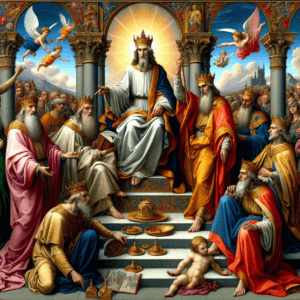 If it is to be noticed, the Spirit of God occupies Himself with the movements of “kings and their armies” only when such movements are in any wise connected with the people of God; otherwise, they are of little significance!
If it is to be noticed, the Spirit of God occupies Himself with the movements of “kings and their armies” only when such movements are in any wise connected with the people of God; otherwise, they are of little significance!
First of all, let me say that this is a historical document. In the first eleven verses, it is recorded that the kings of the east defeat the kings of Sodom and Gomorrah.
For quite a few years, the critical, radical scholars rejected this, saying that these men’s names do not appear in secular history at all and that this is a rather ridiculous story.
But did you know that the names of these kings have been found on monuments and tablets, showing that they did exist?
In fact, Amraphel is now known to be the Hammurabi of other secular history. The record that we have here is tremendously significant.
The first part of Genesis 14 describes battles between various nations and city-states in and around the land of Canaan. It gives us a glimpse into the world at the time of Abram.
Verse 1 lists four kings who became allies in a war against another group of kings. Some of the names and places listed may be connected to names mentioned in other historical records from this time.
Amraphel was king of Shinar, also known as Babylonia. Chedorlaomer (or Kedorlaomer) was king of Elam, east of Shinar. The location of the other two places are not now known, but were likely also to the east of the land of Canaan.
The dispute seems to be over who has ultimate control of the territory. At this time in history, control over a territory had more to do with taxes and trade than direct influence. The rebellion of these kings will take time to correct (Genesis 14:4–5).
Genesis 14:2
That these made war with Bera king of Sodom, and with Birsha king of Gomorrah, Shinab king of Admah, and Shemeber king of Zeboiim, and the king of Bela, which is Zoar.
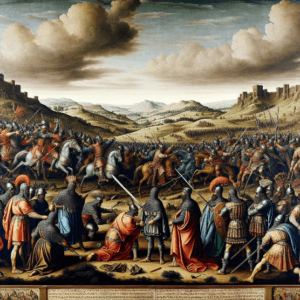 There was war, and this is the first war that is mentioned in Scripture. Mankind began early in making war.
There was war, and this is the first war that is mentioned in Scripture. Mankind began early in making war.
Although this is the first war recorded, I do not know that it is the first war that ever took place—I do not think that the writer intends to give that impression. The reason it is recorded is because Lot, the nephew of Abram, is involved.
The early verses of Genesis 14 are the Bible’s first mention of the word “war.” This narrative gives us some insight into the culture which surrounded men like Abram and Lot.
This culture included various city-states, some of which used the military power to control smaller, weaker groups. Compared to modern warfare, ancient armies were small, and it took a long time to march from one area to another.
And so, when kings chose to rebel against each other, it took some time to resolve (Genesis 14:4–5).
Verse 1 listed four kings who became allies to go to war against another group of five kings. The five kings include Bera, king of Sodom, and Birsha, king of Gomorrah.
The cities of Sodom and Gomorrah are often mentioned together in Scripture (Genesis 13:10. The other three were kings of Admah, Zeboiim, and Zoar.
These five cities may have been grouped together near the southern end of the Dead Sea (or Salt Sea) in the Jordan River valley.
Genesis 14:3
All these were joined together in the vale of Siddim, which is the salt sea.
 All five are located in a small area at the southern end of the Dead Sea called the Valley of Siddim. Moses calls it the Salt Sea, but we now call it the Dead Sea. The previous two verses listed two sets of kings.
All five are located in a small area at the southern end of the Dead Sea called the Valley of Siddim. Moses calls it the Salt Sea, but we now call it the Dead Sea. The previous two verses listed two sets of kings.
The first set of four kings went to war against the second set of five kings, which included the kings of the city-states of Sodom and Gomorrah (Genesis 13:13). Their dispute was over who had ultimate control of the region.
Specifically, whether or not the rebelling kings would continue to be submissive to the existing regime. The forces led by the four kings were there to put down the rebellious forces led by the five kings.
The five kings gathered their forces at a place called the Valley of Siddim (or the Dead Sea Valley). This region is toward the southern end of the Dead Sea. The five kings of the cities of the plain around the Dead Sea prepared to meet the attack of the four kings.
Genesis 14:4
Twelve years they served chedorlaomer, and in the thirteenth year they rebelled.
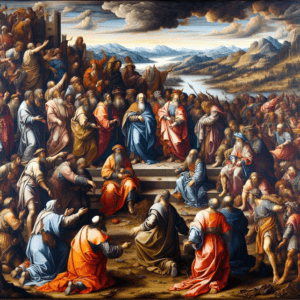 These five kings had been ruled by Chedorlaomer for some twelve years, and now they rebel. The rebellion is what brought the kings of the east against Sodom and Gomorrah.
These five kings had been ruled by Chedorlaomer for some twelve years, and now they rebel. The rebellion is what brought the kings of the east against Sodom and Gomorrah.
These kings evidently had fought before, because the kings of the east had subjugated these cities of the plain, but the cities had reached the place of rebellion.
The previous few verses set the stage for a battle. The rebellious kings of five cities grouped at the southern end of the Sea of Galilee had gathered their forces in the Valley of Siddim to await the attack of the kings of four eastern cities.
In response, the four kings were coming west to attack. These four were from city-states loyal to the ruling regime.
Apparently, these five kings (and perhaps other city-states in the region) had rebelled against the twelve-year rule of the four kings of the east, headed by Chedorlaomer, king of Elam.
This control probably involved taxes and other contributions, rather than direct military occupation.
Genesis 14:5
And in the fourteenth year came Chedorlaomer, and the kings that were with him, and smote the Rephaims in Ashteroth Karnaim, and the Zuzims in Ham, and the Emims in Shaveh Kiriathaim,
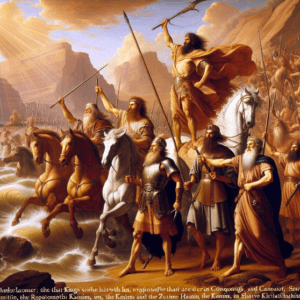 In verses 5–11 we read the account of how the kings of the east overcame the kings who had joined together around the lower part of the Dead Sea.
In verses 5–11 we read the account of how the kings of the east overcame the kings who had joined together around the lower part of the Dead Sea.
For twelve years, Chedorlaomer, king of Elam, and three other kings of eastern city-states had ruled Canaan’s city-states. In the thirteenth year, five of those city-states grouped at the southern end of the Dead Sea (including Sodom and Gomorrah) rebelled.
Perhaps other city-states in the region also rebelled. In the fourteenth year, Chedorlaomer and the other three kings went to war against the Canaanite city-states.
This demonstrates just how long war and politics could take in this era: more than a year passed between the initial rebellion and the resulting invasion.
Their route took them south along a line east of the Jordan river, where they defeated peoples known as the Rephaim, the Zuzim, and the Emim.
The following verses will describe how this path led the four eastern kings back up and around to the Dead Sea, then back northward.
Genesis 14:6
And the Horites in their mount Seir, unto El-paran, which is by the wilderness.
 In the names “Rephaims,”“Zuzims,” and “Emims,” and possibly even the “Horites,” we have, once again, the entrance of the giants, which were a product of the union of fallen angels and women [6:4]. Irrespective of their size, “Chedorlaomer” defeated them.
In the names “Rephaims,”“Zuzims,” and “Emims,” and possibly even the “Horites,” we have, once again, the entrance of the giants, which were a product of the union of fallen angels and women [6:4]. Irrespective of their size, “Chedorlaomer” defeated them.
The previous verse describes how the four eastern kings, led by Chedorlaomer, went to war against the city-states in the Canaan in response to a rebellion against their rule.
Their route took them south through Canaan along a line east of the Jordan River, defeating all in their path, including in this verse the Horites in the hill country of Seir all of the way to the edge of the southern wilderness.
The next verses will describe where their route of destruction took them next as they turned back toward the north. This path will take them through the region occupied by Lot, the nephew of Abram (Genesis 11:31; Genesis 12:4).
Their conquest will inspire Abram to take drastic, heroic action.
Genesis 14:7
And they returned, and came to En–mishpat, which is Kadesh, and smote all the country of the Amalekites, and also the Amorites, that dwelt in Hazezon–tamar.
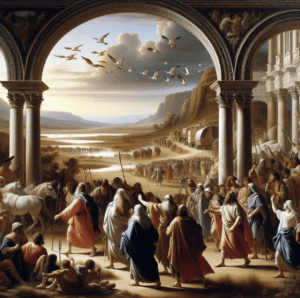 En-mishpat This apparently earlier name means “spring of judgment.” Kadesh would later become a testing time for the children of Israel as they traveled in the desert.
En-mishpat This apparently earlier name means “spring of judgment.” Kadesh would later become a testing time for the children of Israel as they traveled in the desert.
The previous verses described how four eastern kings, led by Chedorlaomer, king of Elam, went to war against the city-states in Canaan in response to a rebellion against their rule.
Their route took them south along a line east of the Jordan River, defeating all in their path all of the way to the edge of the southern wilderness at El-paran.
Next, they turned back to the north and west, defeating En-mishpat (Kadesh), along with the Amalekites and Amorites in the region. That would have brought the four kings, at last, to the southern end of the Dead Sea.
There the five kings of the city-states in that region had gathered in the Valley of Siddim to await their attack (Genesis 14:3).
In the verses to follow, it will finally become clear what all of this has to do with God’s man Abram, who was living in the region.
Specifically, the connection is to Abram’s nephew, Lot, who has chosen to live very near to one of these rebelling cities, Sodom (Genesis 13:10–12).
Genesis 14:8
And there went out the king of Sodom, and the king of Gomorrah, and the king of Admah, and the king of Zeboiim, and the king of Bela (the same is Zoar;) and they joined battle with them in the vale of Siddim;
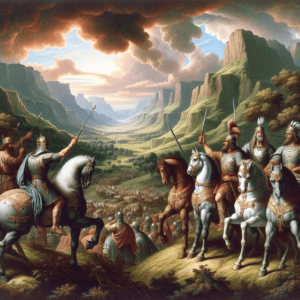 Then the king of Sodom, the king of Gomorrah, the king of Admah, the king of Zeboiim, and the king of Bela (that is, Zoar) went out, and they joined battle in the Valley of Siddim.
Then the king of Sodom, the king of Gomorrah, the king of Admah, the king of Zeboiim, and the king of Bela (that is, Zoar) went out, and they joined battle in the Valley of Siddim.
The previous verses describe the war of the four kings of the east, led by Chedorlaomer, king of Elam, against the city-states and peoples of the land of Canaan.
Defeating all in their path, their route took them south along a line east of the Jordan River all of the way to the edge of the southern wilderness before turning back north to defeat Kadesh and the peoples south of the Dead Sea.
Now the four kings come to the Valley of Siddim to do battle against the five kings listed in this verse. Those five kings include the kings of Sodom and Gomorrah.
It will be helpful to remember that Abram’s nephew Lot had pitched his tents near the city of Sodom, as described in Genesis 13. This puts his family directly in the path of this counter-revolutionary army.
Genesis 14:9
With Chedorlaomer the king of Elam, and with Tidal king of nations, and Amraphel king of Shinar, and Arioch king of Ellasar; four kings with five.
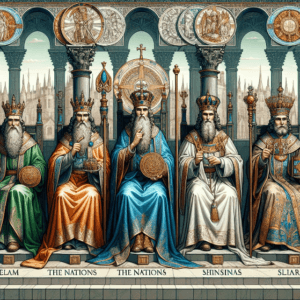 We have in Verse 8 the mention of Sodom, where Lot dwelt, and which causes the interest of Jehovah, and points to the reason for all this being included in these Passages.
We have in Verse 8 the mention of Sodom, where Lot dwelt, and which causes the interest of Jehovah, and points to the reason for all this being included in these Passages.
It is obvious from the Text that Lot was not at all in proper relationship with the Lord; however, the Lord, despite that fact, continued to monitor his every move and, in effect, to exercise a form of security and protection for him, despite his having moved in with the Sodomites.
Every Believer should understand the significance of all of this. You are bought with a price; that price is the shed Blood of the Lord Jesus Christ.
In this passage, four kings of the east, led by Chedorlaomer, king of Elam, have gone to war against the city-states and peoples of the land of Canaan. This is in response to rebellion among these Canaanite tribes.
So far, the army has defeated everyone in its path, a southerly line east of the Jordan River all the way to the edge of the southern wilderness. Then, this counter-revolutionary force turns back north to defeat Kadesh and the peoples south of the Dead Sea.
Now the four kings listed in this verse come to the Valley of Siddim to do battle against the five kings of the city-states grouped at the southern end of the Dead Sea.
Those five kings include the kings of Sodom and Gomorrah. Apparently, the battle won’t last long, since the Bible only describes the aftermath, rather than the battle itself.
Genesis 14:10
And the vale of Siddim was full of slimepits; and the kings of Sodom and Gomorrah fled, and fell there; and they that remained fled to the mountain.

- Slimepits – Asphalt. Apparently crude oil. The kings “fell” in the sense of being totally defeated not killed. Asphalt still tends to surface in the south end of the Dead Sea.
- asphalt pits: The Hebrew term for pits is written twice (“pits pits”), meaning that bitumen pits were everywhere.
The previous verses in this chapter set up a showdown between the four eastern kings led by Chedorlaomer, king of Elam, and the five kings of the city-states grouped around the southern end of the Dead Sea.
These five kings were rebelling against Chedorlaomer’s dozen-year rule over them.
After all that set-up, though, the text tells us nothing of the battle itself. Apparently, it didn’t last long.
The forces of the four kings from the east were strong and had already defeated several peoples and places along their route without ever suffering any loss that we know of.
The five kings of the southern Dead Sea region were no match for them.
The Valley of Siddim, where the battle took place, was full of bitumen (or tar) pits.
A petroleum substance apparently oozed up from under the ground there—an interesting point to consider when one looks ahead to the fiery destruction of Sodom and Gomorrah in the near future (Genesis 19).
On the run from the forces of the four eastern kings, some of the men of the five kings fell into those tar pits. The rest ran into the hills that slope steeply up from the Dead Sea to the east and west.
In any case, the five rebellious kings were thoroughly defeated.
Genesis 14:11
And they took all the goods of Sodom and Gomorrah, and all their victuals, and went their way.
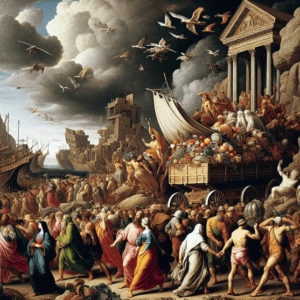 They remove all the animals, food stores and subjects of the city.
They remove all the animals, food stores and subjects of the city.
With the intent to take them back to Babylon.
The five kings of the city-states grouped near the southern end of the Dead Sea, including Sodom and Gomorrah, took their stand against their eastern overlords.
They lost. In fact, their loss seems to be so thorough that the Bible makes no mention of the battle itself. Instead, the narrative skips directly to the aftermath, which includes the rebellious forces fleeing into tar pits and hiding in the wilderness.
The four kings of the east literally sent the forces of the five rebellious kings running.
Afterwards, the forces of the eastern kings looted the cities of Sodom and Gomorrah for all their possessions and provisions, leaving the people destitute.
Among those taken in this plunder are Lot, the nephew of Abram, who has recently moved into Sodom (Genesis 13:10–12; Genesis 14:12).
Genesis 14:12
And they took Lot, Abram’s brother’s son, who dwelt in Sodom, and his goods, and departed.
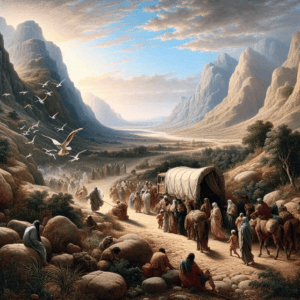 Lot, in his compromised position, could neither deliver Sodom nor himself. The only way to help and bless the world is to live apart from it, in fellowship with God. Lot lived in Sodom and was taken captive.
Lot, in his compromised position, could neither deliver Sodom nor himself. The only way to help and bless the world is to live apart from it, in fellowship with God. Lot lived in Sodom and was taken captive.
The reason this war is significant to the record here is that it reveals what Abram is going to do in connection with his nephew.
After routing the five rebellious kings in battle, the forces of the four kings of the eastern cities sack Sodom and Gomorrah. They take all of the possessions and provisions, leaving the people destitute.
This brings us to the moment where this war story crosses paths with God’s story of the people of Israel: The four kings also took Abram’s nephew Lot and all of his possessions.
It’s important to note that Lot was now living in the city of Sodom—a place known for its obscene wickedness (Genesis 13:13). When last we saw him in Genesis 13:12, Lot had settled his family “near” Sodom.
At some point, then, he and his family moved into this town where the people were known for their wickedness. We are not told why.
Clearly, though, Lot has grown accustomed to Sodom’s sin, at least to the point where he is comfortable living in the middle of it.
Now Lot and all he owns has been taken away by eastern armies, creating another opportunity for God to prove himself faithful to (and through) Abram.
I hope that you have really enjoyed this post,
Please Leave All Comments in the Comment Box Below ↓

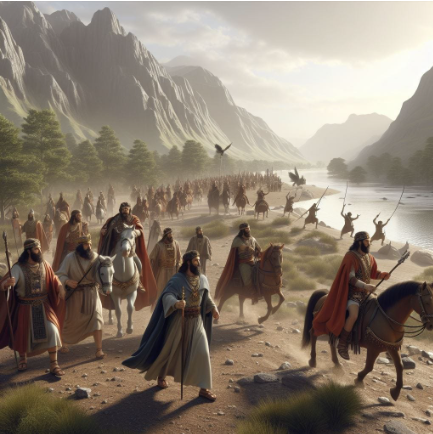






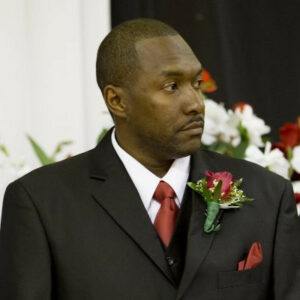



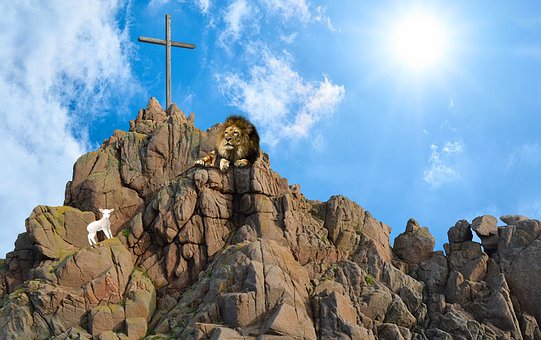
I’ve thoroughly engaged with your commentary on Genesis 14, where you delve into the significance of the war involving the kings of the east and the cities around the Dead Sea.
Your insights into the connections between these events and the overarching narrative are thought-provoking. However, I’d like to inquire about your perspective on the role of Melchizedek in this chapter.
You mentioned that Melchizedek is the first priest and blessed Abram, but could you elaborate on the broader implications of his appearance in the story?
How do you see Melchizedek’s role shaping the spiritual and historical trajectory of Abram’s journey and the unfolding of God’s plan?
Thank you for your insights.
Hello, and welcome back Ashley,
Thank you for stopping by, and continuing to add value to this HBS & DwJ Platform.
Melchizedek, the king-priest of Salem, is foundational for understanding how Jesus occupies the offices of king and priest—a dual honor that finds little to no precedent among Israelite kings.
Melchizedek commands a disproportionate amount of importance in redemptive history compared to the amount of space devoted to him in Scripture. His name literally means “king of righteousness,” and he rules over the city of Salem.
In the three verses that describe his life and ministry (Genesis 14:18–20), we’re introduced to Melchizedek’s authority as king of Salem and “priest of the God Most High.” He speaks of God as both Creator and Deliverer.
He even offers “bread and wine” to Abram after his victory in battle over his enemies.
Your comments and questions are always appreciated, I’d love to hear back from you, feel free to comment on other episodes.
Thanks for continuously stopping by,
Blessings My Friend!
Hello,
I’ve been reading your article on the capture of Sodom and Gomorrah in Genesis 14, and I find it quite intriguing. I’m fairly new to this topic, but I’m eager to learn more.
It’s fascinating to see how this historical account is intertwined with the story of Abram and his nephew Lot. I have a question regarding the significance of this war in the larger context of the story.
You mentioned that this chapter is one of the most important ones in the Book of Genesis.
Could you explain why this particular event holds such significance?
How does the capture of Sodom and Gomorrah connect to the broader themes or messages of the book?
Thank you for shedding light on this!
Hello skamalka,
Welcome back to the HBS & DwJ Platform again.
Sodom and Gomorrah are two of the five “cities of the plain” referred in Genesis 13:12 and Genesis 19:29 that rebel against Chedorlaomer of Elam, to whom they were subject.
At the Battle of Siddim, Chedorlaomer defeats them and takes many captives, including Lot, the nephew of the Hebrew patriarch Abraham. Abraham gathers his men, rescues Lot, and frees the cities.
Later, God gives advance notice to Abraham that Sodom had a reputation for wickedness.
Thanks for stopping by the HBS & DwJ website, turned podcast to comment on The Capture Of Sodom And Gomorrah – The Battle Of Kings.
Please feel free to continue to stop by and share your thoughts on other information on this HBS & DwJ website anytime, your perspective is definitely welcomed.
Your opinion on this topic is very much appreciated.
Blessings To You My Friend!
Thank you for sharing this insightful commentary on Genesis 14. It’s fascinating to see the historical context and significance of this chapter, especially in relation to Abram and his nephew Lot.
The mention of these early wars in the Bible does indeed highlight the connection between the movements of kings and their armies and how they impact the people of God. It’s a reminder that even in these ancient times, God was actively involved in the lives of His people, including Lot, despite his compromised position in Sodom.
The discovery of the names of these kings on monuments and tablets adds an interesting layer of historical confirmation to the biblical account, emphasising the significance of these events.
The story of Lot being taken captive by the Eastern kings and the subsequent actions of Abram in rescuing him show the importance of family bonds and the lengths to which one is willing to go to protect their own. It also foreshadows the continued journey and relationship between Abram and God.
Thank you for sharing these insights, and I look forward to reading more from you in the future.
Hello Demi Foster,
It is great reading another comment from you. It most certain pleases me to learn that you are learning something from each post.
Thank you so much for your continued support.
Please Have A Blessed Day!
Hi there,
I found your article on “The Capture Of Sodom And Gomorrah – The Battle Of Kings” incredibly informative.
It’s great to see such a comprehensive breakdown of this biblical event, especially stressing its significance and impact on figures like Abram and Lot. I’ve always been curious about the deeper meanings behind these stories, and your article has given me a more precise understanding.
I’ve read about Abram’s journey in the past. The role of Melchizedek in this narrative caught my attention.
Does a brief appearance have implications in the grand scheme of biblical events?
Also, with the mention of the discovery of the names of the kings in secular history, can you provide more details on these findings?
Thank you for putting together such a detailed analysis. It’s evident you’ve done thorough research, and I appreciate the effort you’ve put into making these stories more accessible and understandable.
Warm regards
Max.
Hello Makhsud,
Welcome to the HBS & DwJ Platform.
Melchizedek is a mysterious figure mentioned in the Bible who appears briefly but leaves a lasting impact on readers. Despite his brief appearance, numerous questions arise about his identity and significance.
Melchizedek is the only person in the Bible who is both a king and a priest. This dual role makes him a unique figure in biblical history. The encounter between Melchizedek and Abraham is significant because it predates the establishment of the Levitical priesthood, making Melchizedek’s priesthood independent of the Jewish religious system.
Melchizedek’s offering of bread and wine to Abraham foreshadows the institution of the Lord’s Supper by Jesus during the Last Supper, where bread represents his body and wine represents his blood. The author of Hebrews uses Melchizedek as an example to demonstrate how Jesus’ priesthood is superior to the Levitical priesthood because it is eternal, unchanging, and not based on lineage.
Melchizedek’s lack of recorded genealogy in the Bible has led some scholars to speculate that he was an Old Testament appearance of Christ.
The (the names of the kings) list is not history as we would understand it, but a combination of myth, legend and historical information. It starts with the mythological origins of kingship, when individuals have fantastically long reigns.
This is followed by the famous lines: ‘The Flood swept over. After the Flood had swept over and kingship had descended from heaven’. The flood is the subject of other major works in Mesopotamian literature and the story was adapted in the Old Testament to form the basis of the account of Noah.
As the list reaches historical rulers the length of each reign becomes more realistic. It ends with King Sin-magir of the so-called Isin dynasty (around 1827–1817 BC).
The Sumerian King List seems to have been composed to imply that the dominion of Mesopotamia, determined by the gods, could only be exercised by one city at a given time and for a limited period. In this way the rulers of the city of Isin legitimised themselves as the rightful successors of powerful kingdoms of the past.
Thank you for stopping by, as well as your interest in this platform,
Blessings My Friend!!!
The layout of the website is pretty good.
I do like the map of Jerusalem, as it explains the main background about Jesus. In addition, the map includes the timeline about Abraham and the four kings of Mesopotamia.
The historical relevance to the biblical quotes are also helpful in terms of the King of Mesopotamia. The background in the image of Mesopotamia looks organized and had arrows to follow through with the directions of where the historical facts took place.
Hello Anshu,
Thank you for liking the map of Jerusalem, as well as, your comments on the subject at hand.
I really appreciate your valuable time.
Blessings My Friend!